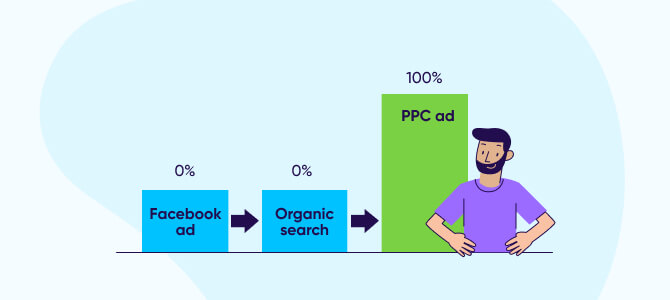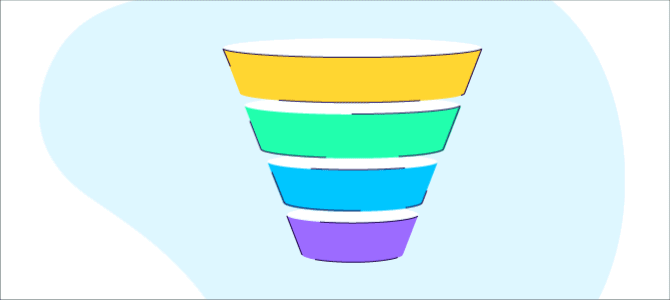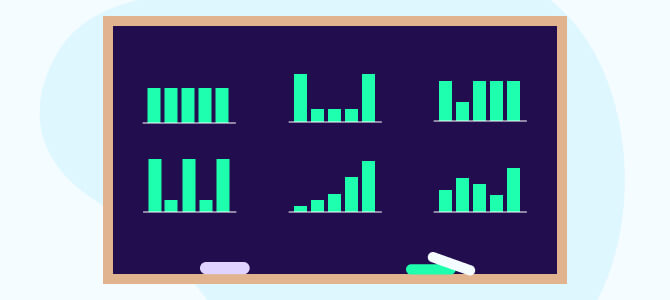
Last-click attribution

The last-click attribution model credits the final touchpoint in the buyer’s journey as the influencing factor that converted a lead into a customer.
What is last-click attribution?
Last-click attribution measures which touchpoint — an ad, blog, video, or web page — the customer last clicked on before making a purchase. It assumes this touchpoint is what pushed the lead to place an order, helping marketers identify marketing channels and touchpoints that have the most influence in the final stage of a buyer’s journey.
Here’s an example to help you understand how last-click attribution works in practice:
Suppose Ben visits your website through a Facebook ad. He explores your site but doesn’t convert. A few days later, Ben Googles your company name to look around your website again but doesn’t convert. He sees a PPC ad later and visits your website through it, signs up for a free demo, and finally converts after seeing the demo.

Under the last-click attribution model, you’ll give all the credit for the conversion to the PPC ad and ignore other touchpoints (Facebook ad, organic search).
What’s the challenge with last-click attribution?
In our example, the full credit of Ben’s conversion was attributed to the PPC advert, but this presents an incomplete picture of his buying journey.
When you only give credit to the last clicked ad and its corresponding keyword, you ignore all other touchpoints along the conversion path — touchpoints that helped the user become aware of your brand and guided them towards becoming a customer.
Here are a few additional disadvantages of using this model:
Fragmenting the customer journey
Before making a purchase, customers make numerous contacts with your brand and products (consider how Ben visited your website several times before signing up for the demo).
With a last-click attribution model, the entire customer journey is narrowed down to a single touchpoint, which limits your understanding of your customer’s actions. Plus, you don’t have the complete picture of how your branding and awareness efforts are affecting your campaign as a whole.
Feeding your analytics with misleading traffic metrics
Last-click attribution can cause marketers to rely on the wrong metrics. You only see how your marketing channels are working to close sales; once you identify what works to convert leads, you eventually stop paying attention to other metrics that indicate how leads are finding your company.
For example, your blog could be driving a lot of traffic to your website, but looking only at the bottom line you might end up neglecting it because, according to last-click attribution, it’s driving no conversions.
Ignoring the traditional conversion funnel

When you use last-click attribution, you prioritize conversion-driving marketing channels. This is a potentially problematic approach as you need to understand how different channels fit across the different stages of the buyer’s journey, especially if you want to optimize your marketing strategy.
The last click generally accounts only for bottom-of-the-funnel interaction (action) and doesn’t consider top-of-the-funnel and middle-of-the-funnel interactions (awareness, interest, and desire), which are prerequisites for a lead to convert.
In a nutshell, the last touchpoint a prospect interacts with before converting isn’t necessarily the main cause of conversion. That’s why most businesses opt for a more comprehensive and accurate model like multi-touch attribution — that assigns credit across different touchpoints based on their impact on the customer journey.
Last-click attribution alternatives

If you want to dig deeper into your marketing analytics, you can opt for more effective last-click attribution alternatives:
Multi-touch attribution (MTA)
Multi-touch attribution is a marketing measurement method that considers multiple online and offline touchpoints on the buyer journey, and then assigns fractional credit to each — so that marketers can understand how much influence each channel has on conversion.
75% of companies use this attribution model to gain a better view of the customer journey
Single-touch attribution
Single-touch attribution is an attribution model that assigns 100% of conversion credit to one marketing touchpoint or a single campaign. It’s why this attribution model is the easiest to implement but is also less credible. Common single-touch variations include first touch, last touch, and stage-based touch.
Last click vs. First click attribution
Last-click attribution considers the last time a customer engaged with your company before converting the most important touchpoint. With first-click attribution, it’s the opposite—the first interaction a customer has with your company is usually considered the main reason they bought your product or service.
Last-click works well to increase your conversion rates and is mostly focused on refining the bottom-of-the-sales funnel. Contrarily, first-click is a great strategy to attract more prospects and increase brand awareness, while overemphasizing top-of-the-funnel activities.
Key takeaways
- Last-click attribution helps you identify the last customer touchpoint in the buyer’s journey before they convert. With this model, you can determine which marketing channels and touchpoints have the most influence in the last stage of the buyer’s journey.
- Unfortunately, last-click attribution only gives you a limited view of customer actions, which is why in most cases — it’s better to opt for more comprehensive attribution models like multi-touch attribution.



